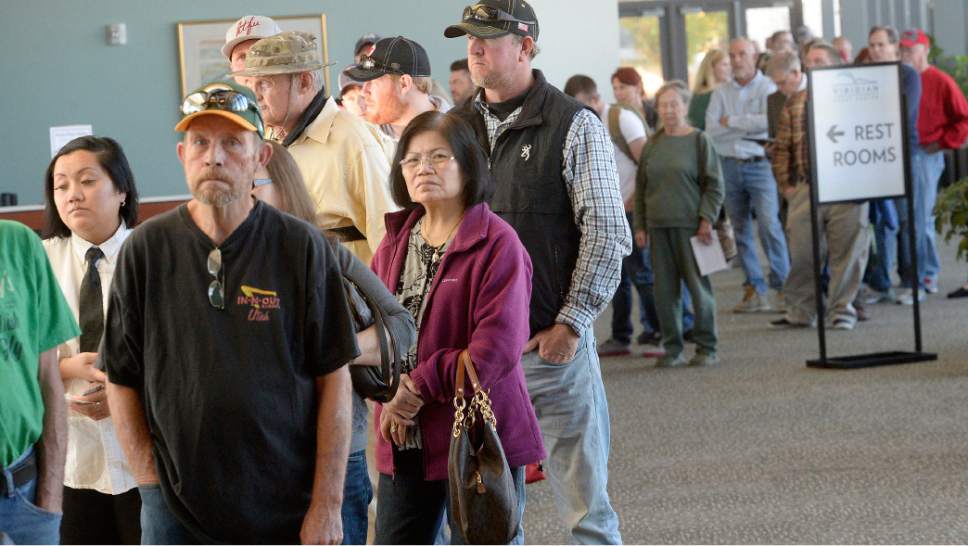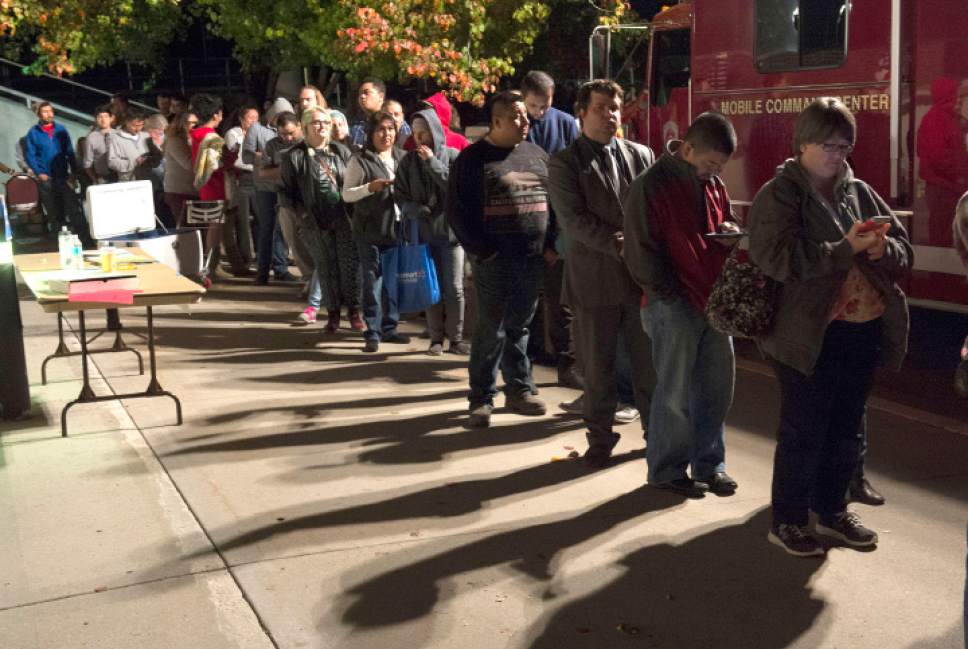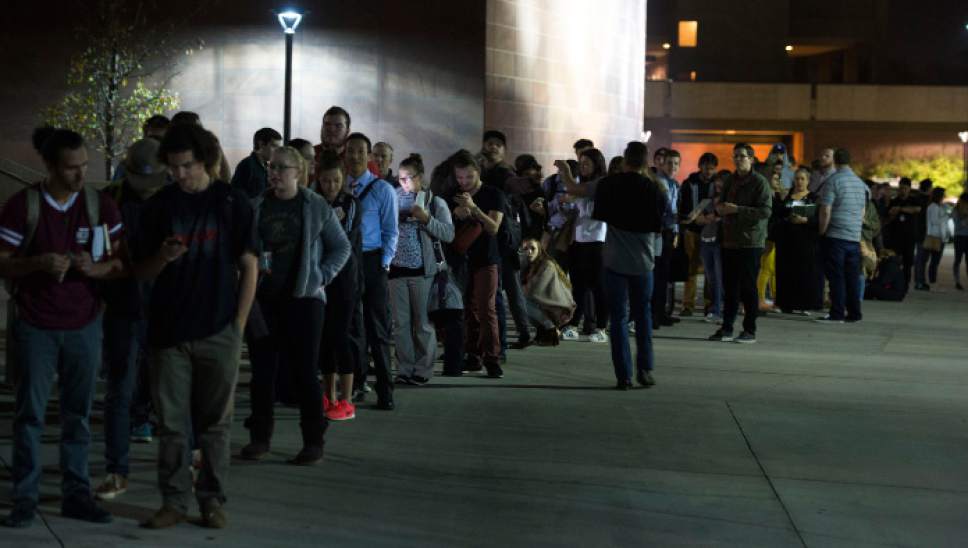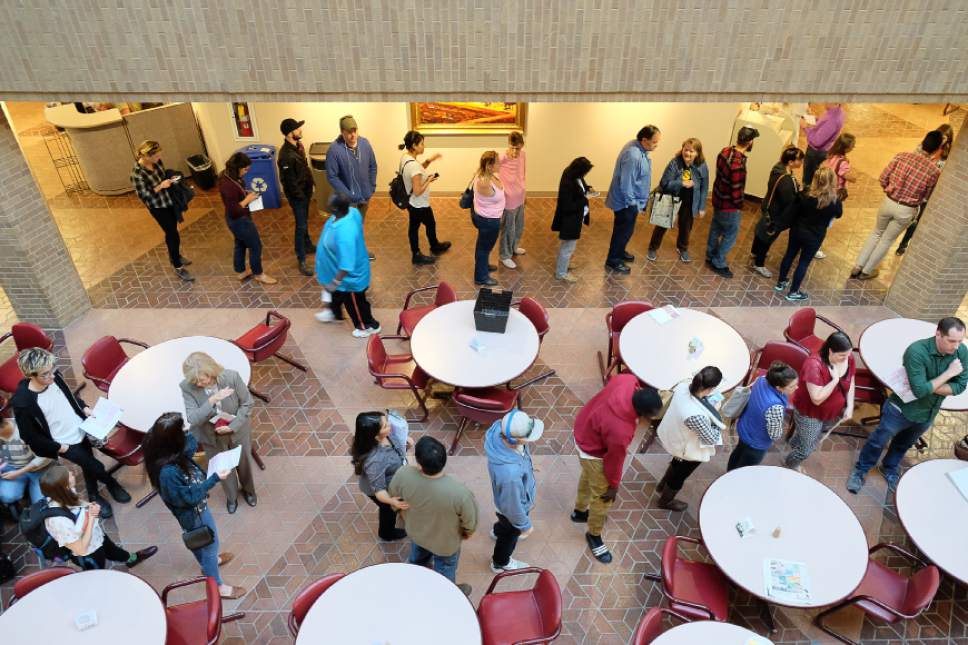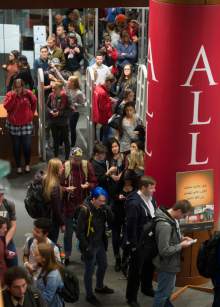This is an archived article that was published on sltrib.com in 2016, and information in the article may be outdated. It is provided only for personal research purposes and may not be reprinted.
In Salt Lake County, voters stood in line for hours — in some cases until after midnight — before casting ballots.
What went wrong? Call it a tsunami, said longtime Salt Lake County Clerk Sherrie Swensen:
• The volume of mail-in ballots didn't come in as expected.
• Only 37 voting centers were available countywide, down drastically from the precinct system that offered some 300 polling places in previous elections.
• Salt Lake County was one of eight counties participating in a pilot program that allowed residents to register and vote the same day — a time-consuming process that slowed lines to a crawl.
• Many voters waited until the last minute to cast ballots in this presidential election, which saw a rowdy, unprecedented campaign.
• And, finally, top it all off with a huge turnout — an estimated 80 percent in Salt Lake County, the state's most populous.
But the public remained in the dark on local election results. Swensen's office did not release any tallies until 11:16 p.m. Tuesday, after receiving a recommendation from the lieutenant governor's office not to do so while voters were waiting in line. Such information, election officials believe, may dissuade would-be voters from casting ballots.
Mark Thomas, state director of elections, said Salt Lake County ought not point fingers at the state for its long delay in releasing returns.
"This was something we had been working on for weeks and months," he said, "how to handle election results while people were still in line."
But Thomas added that his office was considering timing that was more like 8:30 p.m. — 30 minutes after the posted poll-closing time — as opposed to 11:30 p.m.
"It's unfair for Sherrie [Swensen] to point fingers at us," Thomas said. "No one anticipated people waiting in line until 11:30."
Swensen is an independently elected official and need not heed such advice. Nonetheless, the state email to county clerks does not indicate a time element. It states, in part: "Please wait until all voters in your county, including those who are standing in line when the polls close, have had a chance to cast their ballot before sending us your preliminary results."
Publication of vote counts not withstanding, it was a troublesome Election Day in Salt Lake County and some other Utah locations. Problems with voting machines in St. George caused problems, and a flood of in-person voters at the single Cedar City voting center produced three-hour-long lines there.
"What a horrible day," Swensen said Wednesday. "I'm so sad to see people wait in line. It's a worst-case scenario."
By Nov. 1 — seven days before the election — Swensen realized trouble was brewing when only fractions of the 510,000 mail-in ballots sent out were trickling in.
Although mail-in balloting worked well in the much-smaller 2015 municipal elections, only an estimated 25 percent to 30 percent of voters in Salt Lake County put ballots in the mail box this year.
Why that is, Swensen doesn't know. But it set the stage for a challenging Election Day.
"I said, we've got a tsunami coming," Swensen recalled. "I wanted to add vote centers ... but I couldn't adjust because of the restriction on bonds."
According to Utah law, a $90 million parks and recreation bond on the Salt Lake County ballot required three weeks' public notice of polling places.
Swensen said she added voting machines and increased personnel at the 37 voting centers. "I deployed every resource I could," she said.
It wasn't enough.
After the 2015 election, Swensen was determined to focus on mail-in while continuing to offer a modest number of voting centers. The county clerk said she has long believed that the old precinct system was flawed because it depended on public schools.
Visitation at schools is closely monitored, except on Election Day, when anyone can walk in, Swensen said. That allowed at least one instance of a sex offender threatening to enter a school and another case of theft. One Election Day, a school went into lockdown after a crime had been committed nearby, preventing voters from exercising their franchise.
"Schools are a bad idea," she said. "What we are doing is allowing all these people into schools and we don't know who they are... This is frightening."
Improving the system may require doing away with same-day registration, said Swensen, previously a vocal advocate of the program.
The pilot project is over, Thomas said. It will be up to the Legislature to determine whether to continue the program.
"We will take it to the Legislature," he said. "We will have to weigh the pros and cons."
Further, Swensen said, she will consider increasing the number of voting centers.
She also would like to be able to adjust those numbers as an election nears. That could require a change in Utah law — at least as it applies to bond measures.
"You have to be able to adjust when you see trends," she said.
Voters may wish that such adjustments are made well in advance of the next election, rather than in reaction to a quickly rising tide.


